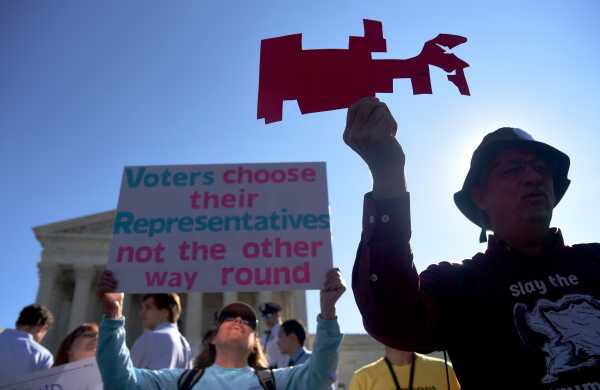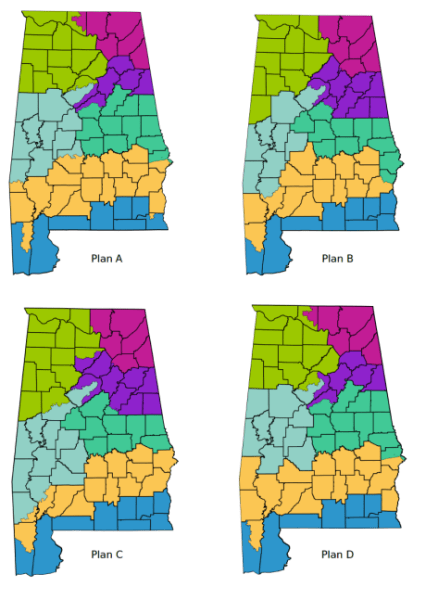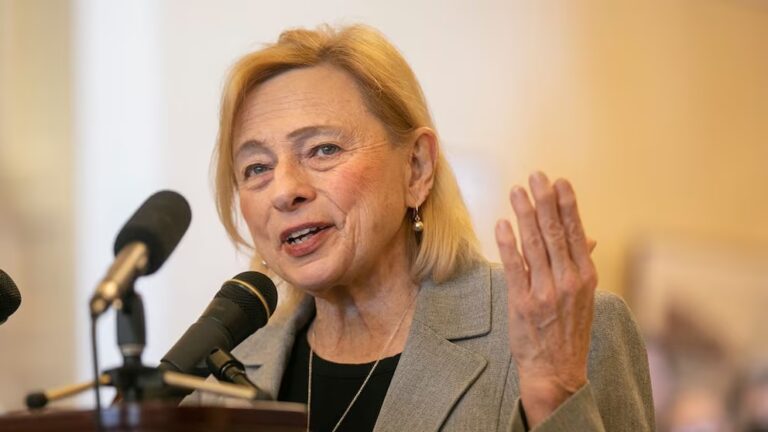
Cases alleging racial gerrymandering are notoriously difficult to litigate, much less to win. And the path that brought Merrill v. Milligan to the Supreme Court — the justices will hear the case on Tuesday — shows why.
The lawsuit deals with Alabama’s congressional maps, which would give only one of the state’s seven congressional districts — 14 percent of the state’s total population — a real chance of electing a Black representative, even though African Americans make up about 27 percent of Alabama’s population.
In a decision handed down in January, a panel of three federal judges spent 225 pages walking through the nauseatingly complex legal test for identifying such gerrymanders laid out by the Supreme Court’s decision in Thornburg v. Gingles (1986). Ultimately, that panel — which includes two judges appointed by then-President Donald Trump — concluded that Alabama must draw new maps that would effectively double the number of Black US House members from Alabama.
Help inform the future of Vox
We want to get to know you better — and learn what your needs are. Take Vox’s survey here.
Indeed, this panel, despite being dominated by Trump appointees, wrote that they did not view the question of whether Alabama violated the federal Voting Rights Act to be “a close one.”
Just a couple of weeks after the lower court ruled, however, the Supreme Court voted 5-4 to reinstate the challenged maps for the 2022 midterms. The Court will now hear arguments about whether to reinstate those maps permanently. Given the Court’s earlier decision in this case, and most of the justices’ record of hostility toward Voting Rights Act claims, there isn’t much doubt who will prevail in this case.
But a lot still hinges on how the Court might decide to rule in Alabama’s favor — assuming that the five most conservative justices follow the same path they took last winter. In its brief defending its congressional maps, Alabama briefly nods to a narrow, fact-bound argument that could allow the Supreme Court to bless its maps without having to tear up any existing law. But it also pushes several arguments that would require the Court to overrule Gingles, neutralize much of what remains of the Voting Rights Act, and potentially eliminate nearly all federal safeguards against racial gerrymanders.
Alabama’s most radical arguments would effectively abolish the Voting Right Act’s safeguards against racial gerrymandering. They would preserve separate limits that the Constitution’s 14th and 15th Amendments impose on state election laws that discriminate on the basis of race. But, as anyone even vaguely familiar with the history of the Jim Crow South would know, these constitutional safeguards did virtually nothing to prevent the South from suppressing the Black vote.
In the worst-case scenario for voting rights, in other words, Merrill could enable states to draw maps that destroy nonwhite voters’ ability to cast a ballot that actually means anything.
Winning a racial gerrymandering lawsuit is already quite difficult
A few years ago, in Rucho v. Common Cause (2019), the Court’s Republican appointees declared that federal courts may do nothing to stop partisan gerrymandering — that is, legislative maps that give an unfair advantage to Democrats or Republicans. But the Voting Rights Act still provides important safeguards against racial gerrymandering, maps that give voters of a particular race an unfair advantage over voters of a different race.
While direct challenges to partisan gerrymanders are no longer permitted in federal court (they do sometimes prevail in some state courts), racial gerrymandering lawsuits often have significant partisan implications. In Alabama, for example, 89 percent of Black voters supported Democratic President Joe Biden in 2020, while 77 percent of white voters supported Republican Donald Trump, according to CNN’s exit polls. So a map that targets Black voters will also weaken Democrats.
This all said, the law currently governing racial gerrymandering is a bit of a mess. Although Chief Justice John Roberts dissented from the Court’s decision reinstating Alabama’s maps for the midterm election, he also signaled that he is dissatisfied with current law and eager to make a change. The legal rule laid out in Gingles, Roberts wrote, has “engendered considerable disagreement and uncertainty regarding the nature and contours” of a racial gerrymandering claim brought under the Voting Rights Act.”
He’s not wrong about that.
The rule laid out in Gingles requires a voting rights plaintiff to make several demonstrations just to get a court to consider their claim that a map is an illegal racial gerrymander. Plaintiffs alleging that a state’s maps do not give enough representation to Black voters must show that the state’s African American population is “sufficiently large and geographically compact to constitute a majority” within an additional district.
Ordinarily, voting rights plaintiffs make this demonstration by producing one or more sample maps that include the required number of districts where a racial minority group makes up a majority of voters. As Justice Elena Kagan explained in her dissent from the Court’s first decision in Milligan, the purpose of these sample maps is to show “that what [the plaintiffs] are asking for is possible.”
Plaintiffs must also show that Black voters in the state are “political cohesive,” and that the state’s white majority “votes sufficiently as a bloc to enable it . . . usually to defeat the minority’s preferred candidate.” In other words, the voting rights plaintiff must show that Black voters in a state tend to vote together for one candidate or one party, while white voters tend to vote together for opposing candidates or parties.
Even if a voting rights plaintiff clears these bars, however, that’s only the beginning of their journey. A court hearing Voting Rights Act challenge to a gerrymandered map must still consider a non-exhaustive list of at least nine factors, ranging from whether the state in question has a “history of official discrimination” to “whether political campaigns have been characterized by overt or subtle racial appeals,” before it can declare a map invalid.
Alabama proposes several alternatives to Gingles, some of which would make these kinds of lawsuits impossible to win
The plaintiffs in Merrill primarily ask the Supreme Court to stick to the Gingles framework — an understandable strategy, given that they won in a lower court that applied Gingles, and because the current Court is prone to move the law dramatically to the right if it does decide to overrule longstanding precedents.
Alabama, meanwhile, proposes a hodgepodge of ways that the Court could rule in its favor. Some of these proposals are relatively modest, while others would eliminate the Voting Rights Act’s protections against racial gerrymandering almost in their entirety.
Buried deep in Alabama’s brief (on pages 63 and 64 of an 81-page brief, to be precise) is a perfectly normal argument that Black voters in Alabama do not live close enough together to justify drawing a second majority-Black district — an argument that would permit Alabama to prevail under Gingles. “Black voters are concentrated in the State’s four largest cities: Huntsville, Birmingham, Montgomery, and Mobile,” the state’s lawyers write, claiming that “none of these geographically dispersed cities includes enough black Alabamians to constitute a majority of a single congressional district.”
The problem with this argument is that the Merrill plaintiffs introduced several sample maps that show that, yes, it is possible to draw two majority-Black districts in Alabama. One group of plaintiffs, for example, hired Tufts University mathematics professor Moon Duchin to produce four sample maps.

Meanwhile, one of Alabama’s most extreme proposals asks the Court to rule that the Voting Rights Act “does not apply to challenges to single-member districts” — meaning that the act’s safeguards against racial gerrymandering would cease to exist altogether, so long as a state uses legislative districts that each elect exactly one person to office, as opposed to a system where a single district elects multiple lawmakers.
No state currently uses multi-member districts to select members of Congress, although some use them to choose state lawmakers.
Elsewhere in its brief, Alabama proposes imposing a kind of Catch-22 on plaintiffs challenging racial gerrymanders: Keep the requirement that these plaintiffs produce a sample map demonstrating that it is possible to draw more districts where racial minority groups are in the majority, but require plaintiffs to do so without paying too much attention to race.
“If Gingles is to serve any gatekeeping role, race cannot predominate in the districts a plaintiff proposes to satisfy that precondition,” the state’s lawyers write.
But it’s unclear how this proposal is supposed to work — unless its sole purpose is to shut down challenges to racial gerrymanders altogether. If the law requires the Merrill plaintiffs to produce sample maps that include at least two majority-Black districts, how, exactly are they supposed to do that without paying close attention to race while they draw the sample maps? It’s like asking an artist to produce a detailed and realistic painting of a camel, without ever allowing that artist to look at a camel.
In yet another part of its brief, Alabama suggests that a map should be upheld so long as it comports with “race-neutral, traditional redistricting criteria,” such as drawing compact districts, limiting the number of counties that are split, and ensuring that “communities of interest” — groups of people who share a similar culture, economic interest, or livelihood — are combined together in one district.
In theory, this approach would preserve some safeguards against racial gerrymandering — maps featuring ugly, misshapen districts, for example, could still potentially be vulnerable. In practice, however, it likely raises more questions than it answers. Exactly how compact must a district be before it becomes too sprawling? If splitting counties is unavoidable, how many may be split before the maps become invalid? And what happens if mapmakers have to choose between splitting one community of interest or another?
Alabama, for example, faults the lower court for “dismantling the Gulf Coast district,” which, according to one of the state’s witnesses, “has a distinct shared culture based on its French and Spanish colonial heritage.” But the lower court countered that the plaintiffs’ maps do a better job of preserving Alabama’s Black Belt, a culturally distinct region known for its fertile soil and history of using enslaved Black labor to harvest cotton.
Alabama’s “traditional redistricting criteria” proposal, in other words, would likely give enormous discretion to a judiciary dominated by conservative Republican appointees. There are no clear answers to questions like “how compact must congressional districts be?” or “is it better to split up Gulf Coast communities or Black Belt communities?” So this proposal would likely give the Supreme Court, with its 6-3 Republican-appointed supermajority, a tremendous amount of leeway to strike down maps it wants to strike down, and to uphold maps it wishes to uphold.
It would also give states a fair amount of freedom to draw gerrymandered maps, so long as those maps have districts that aren’t misshapen or obviously flawed in some way.
Alabama wants to relitigate a fight that Congress settled in 1982
Although Alabama proposes many alternatives to Gingles, a common theme that runs throughout its brief is that states should be allowed to draw maps freely so long as they do not do so with racist intent. At one point, the brief claims that a voting rights plaintiff should only prevail if they can “establish irregularities in the State’s enacted plan that can be explained only by racial discrimination.” At another, it argues that “the absence of racially discriminatory intent” must be a “relevant consideration” in any legislation seeking to combat racism in elections.
But this argument is entirely at odds with the text of the Voting Rights Act, which provides that any state law that “results in a denial or abridgement of the right of any citizen of the United States to vote on account of race or color” is illegal, even if the law was not motivated by racist intent.
This fight, over whether voting rights plaintiffs need to show racist intent or merely need to prove that a law has negative effects on a minority group, flared up early in the 1980s. In City of Mobile v. Bolden (1980), the Supreme Court took a position much like the one Alabama urges it to adopt now — ruling that a law is only vulnerable to a Voting Rights Act lawsuit if the lawmakers who enacted it acted with “racially discriminatory motivation.”
But Congress disagreed with the Court’s decision in Mobile, and it enacted legislation adding the Voting Rights Act’s current “results in a denial or abridgement” language for the specific purpose of changing the rule announced in Mobile.
Although President Ronald Reagan eventually signed this legislation into law, a conservative faction within Reagan’s administration urged him to veto it. One of the central figures in this faction was future Chief Justice John Roberts. According to voting rights journalist Ari Berman, “Roberts wrote upwards of 25 memos opposing an effects test.” He “drafted talking points, speeches and op-eds for” senior Justice Department officials opposing the amendment, and “prepared administration officials for their testimony before the Senate; attended weekly strategy sessions; and worked closely with like-minded senators on Capitol Hill.”
Now, however, Roberts is one of six Republican appointees to the Supreme Court — indeed, if anything, he’s the most moderate member of the Court’s GOP bloc. That means that he and his five allies now have the power to rewrite history, and to rule that the Voting Rights Act must be interpreted as the losing faction wanted it to be understood in 1982.
And all they have to do to accomplish this goal is ignore the explicit text of the law.
Our goal this month
Now is not the time for paywalls. Now is the time to point out what’s hidden in plain sight (for instance, the hundreds of election deniers on ballots across the country), clearly explain the answers to voters’ questions, and give people the tools they need to be active participants in America’s democracy. Reader gifts help keep our well-sourced, research-driven explanatory journalism free for everyone. By the end of September, we’re aiming to add 5,000 new financial contributors to our community of Vox supporters. Will you help us reach our goal by making a gift today?
Sourse: vox.com






